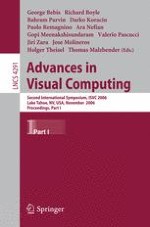It is with great pleasure that we welcome you all to the proceedings of the 2nd InternationalSymposiumonVisualComputing(ISVC2006)heldinLakeTahoe. Followinga successfulmeeting lastyear,wewitnesseda muchstrongerandmore productive event this year. ISVC o?ers a common umbrella for the four main areas of visual computing including vision, graphics, visualization, and virtual reality. Its goal is to provide a forum for researchers, scientists, engineers and practitionersthroughouttheworldtopresenttheirlatestresearch?ndings,ideas, developments and applications in the broader area of visual computing. This year, the program consisted of 13 oral sessions, one poster session, ten special tracks, and six keynote presentations. The response to the call for - pers was very strong. We received more than twice the papers received last year. Speci?cally, we received over 280 submissions for the main symposium from which we accepted 65 papers for oral presentation (23% acceptance) and 56 papers for poster presentation (20% acceptance). Special track papers were solicited separately through the Organizing and Program Committees of each track. A total of 57 papers were accepted for presentation in the special tracks. All papers were reviewed with an emphasis on potential to contribute to the state of the art in the ?eld. Selection criteria included accuracy and originality of ideas, clarity and signi?cance of results, and presentation quality. The review process was quite rigorous, involving two to three independent blind reviews followed by several days of discussion. During the discussion period we tried to correct anomalies and errors that might have existed in the initial reviews.
